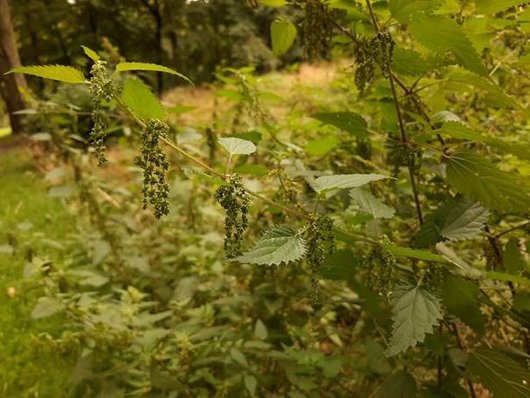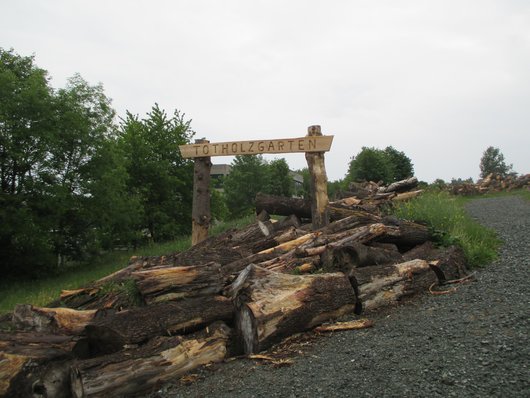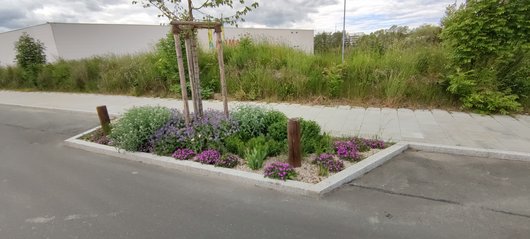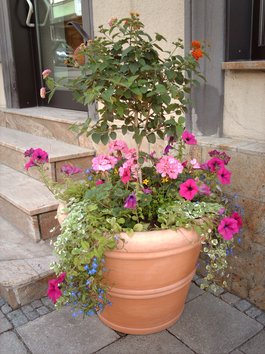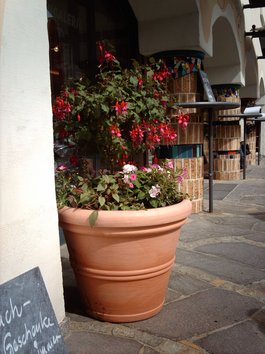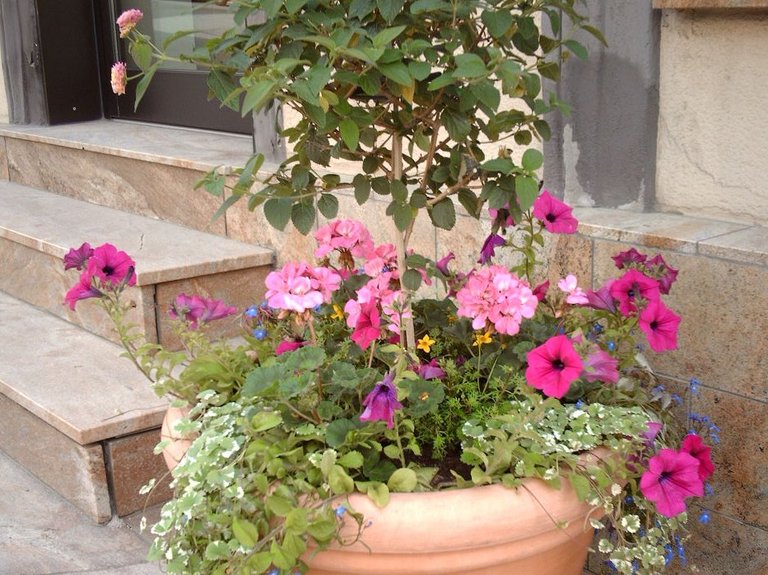Urban green for people and the environment
Colorful alternating plantings to enhance the cityscape with spring bloomers and summer flowers adorn small areas in the city center and at prominent locations in the urban area. In doing so, the city of Hof is also fulfilling the wishes and suggestions put forward by the "Save the bees" referendum in 2019.
Stinging nettles on the Theresienstein
New mowing concept for more biodiversity
To promote biodiversity, the city of Hof is changing the way it maintains its green spaces. Areas are mowed less frequently so that plants can bloom there. In addition, strips of fallow land are deliberately left during the mowing process so that insects and small animals can find refuge and food there.
The mowing concept is also being changed at Theresienstein and areas remain unmown. If stinging nettles grow here and there as a result, this is a good thing, as the herb is an important food plant for insects and birds. It contains many vitamins and nutrients, which is why it has been used as a cultivated and medicinal plant for thousands of years.
"We want to actively do something for insect and bird diversity in the city of Hof. One small way of achieving this is to promote a wide variety of plant structures and mosaics in green spaces. This also includes leaving stinging nettles or thistles in some areas," explains Isabel Kaske from Landschaftspflegeverband Landkreis und Stadt Hof e.V. and manager of the "Wir machen Insekten den HOF!" project. As part of the project, she advises the city of Hof and the district farms of the district of Hof on insect-friendly green space maintenance. Ms. Kaske continues: "If you would like to do something for insect diversity in your garden yourself, we recommend you take a look at the Blühpakt Bayern homepage. There you will find numerous tips on how you can transform your garden into a buzzing and blooming paradise."
Over the next two years, the project "Wir machen Insekten den HOF!" (We're giving insects the YARD!) will work together with the city and district authorities and farmers to create species-rich areas on municipal land and provide advice on insect-friendly care. It is part of the "NATÜRLICH BAYERN - insect-rich habitats" initiative of the German Association for Landscape Conservation (DVL) and is funded by the Bavarian State Ministry for the Environment and Consumer Protection.
However, the needs of humans and animals should be equally taken into account, especially in the Bürgerpark, emphasizes Christoph Grzesiak, head of the green spaces department of the city of Hof. "Lawns and picnic areas will continue to be mowed several times a year so that residents can feel comfortable there. Strips next to the paths are also mowed so that no plants interfere."
"Deadwood garden"
... is full of life
Large quantities of wood accumulate in our towns and communities every year: Trees have to be felled, some even have to be felled. Unfortunately, this wood ends up being "recycled" far too quickly.
The extreme decline in insects due to a lack of food sources caused by monocultures in the countryside and in our gardens and housing estates has made it important to help by creating suitable habitats such as deadwood gardens, flower meadows, etc. to provide assistance.
By creating a deadwood garden, a special habitat is created for insects, bees, beetles, mosquitoes and butterflies. Frogs, toads, slow worms, snakes, hedgehogs and small mammals find shelter and winter quarters here.
The deadwood garden, in the Rosenbühl area above the school center, was founded in 2019 to protect our insects and small animals and was completed in spring 2020.
Colorful instead of grey
Low-maintenance alternatives to the gravel garden
The "gravel garden" trend has been around for a few years now. Garden owners are opting for gravel instead of plants.
However, the gravel garden is not a garden, but legally a paved area that has a high degree of sealing due to fleece and foil.
Such areas have many disadvantages for garden owners, but also for nature:
Expensive to purchase
Insects, birds and other garden animals find neither food nor habitat
A gravel garden does not last long without maintenance
Quickly unsightly due to algae and plant growth
Regular cleaning necessary - use of leaf blowers and high-pressure cleaners costs energy and damages small creatures
Gravel heats up considerably in summer
Fine dust is not filtered, dust pollution increases
Noise is increased
Soil is compacted and destroyed, requiring extensive renaturation at a later date
Water cannot seep away at all or only with difficulty, flooding is favored
Gravel gardens look monotonous
May have a negative impact on rainwater charges
After some time, a breeding ground forms in the gravel garden between the stones due to dust and leaves, in which grasses and herbs grow, so that weeding is still necessary. The use of weedkillers is prohibited on such areas and fines of up to 50,000 euros can be imposed.
For a low-maintenance, insect-friendly front garden, it is not necessary to dispense with stones and gravel, just fleece and plastic sheeting. Once it has been ensured that there is no soil-sealing material under the gravel layer, unwashed sand, i.e. sand with fine particles, can be applied. Some weed-free green compost can also be added. For particularly undemanding perennial mixtures, it is sufficient to add a crushed mineral mixture with a grain size of 0/32 or 0/45 that is low in fines.
Suitable plant and seed mixtures for the lean site created in this way are available commercially, from perennial nurseries, seed producers and gardening and landscaping companies.
Maintenance is generally limited to pruning in late winter and weeding two to three times a year.
Information and tips on low-maintenance planting can be obtained from nature conservation associations, horticultural societies, the Bavarian State Institute for Viticulture and Horticulture and the green spaces department of the city of Hof.
Hof blossoms
Planter campaign
Sponsorships for planters have been taken on for several years now.
Throughout the summer, the citizens and guests of our city, as well as insects, can enjoy the well-maintained planters in our city center. Both the care and watering of the planters is lovingly undertaken by our sponsors.
The cost is €120.00 per planter. For locations with limited space, smaller planters are available for €80.00.
The form for ordering the planters is posted on our homepage in spring. Invoicing always takes place in the fall.
